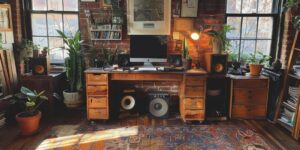The Interior Design Blog
Why Homeowners Are Ditching Coffee Tables for This Stylish Alternative
The Rise of Multipurpose Furniture
In recent years, homeowners have increasingly sought out furniture that does more than just look good. The trend towards multipurpose furniture is driven by the need for practicality and space efficiency, especially in smaller living areas. Traditional coffee tables, while classic, often serve a singular purpose. Enter the era of multifunctional alternatives that offer more than meets the eye.
These alternatives frequently combine storage, style, and utility, making them an attractive option for modern living. For instance, ottomans with hidden storage or lift-top tables that double as workspaces are becoming popular choices. They not only serve as a place to put your coffee cup but also help declutter living spaces by offering additional storage or functionality.
Homeowners are gravitating towards these options because they can adapt to various needs. Whether it’s hosting a casual gathering, working from home, or simply relaxing, multipurpose furniture provides flexibility. This adaptability is crucial in today’s dynamic lifestyles, where spaces often need to transform quickly from one function to another.
Design and Aesthetic Appeal
Another reason homeowners are moving away from traditional coffee tables is the desire for a fresh aesthetic. Modern alternatives often feature sleek designs and innovative materials that can elevate the look of any room. Unlike the static nature of a coffee table, these pieces can be more visually engaging and versatile in their design.
For example, nesting tables or modular units offer a contemporary twist, allowing for dynamic configurations that suit different occasions. These pieces can be arranged to create unique setups that reflect personal style and taste. Additionally, the variety of materials available—ranging from reclaimed wood to metal and glass—enables homeowners to match their furniture with the rest of their decor seamlessly.
Moreover, the aesthetic versatility of these alternatives means they can complement a wide range of interior styles, from minimalist to eclectic. This adaptability not only enhances the visual appeal of a space but also ensures that the furniture remains relevant even as trends evolve.
Practical Benefits and Space Optimization
The practical benefits of ditching traditional coffee tables for more versatile options are significant. In urban living environments, where space is often at a premium, every piece of furniture must justify its footprint. Alternatives that offer storage or additional functionality help maximize the use of available space.
For instance, a lift-top coffee table can serve as a dining area in a small apartment, eliminating the need for a separate dining table. Similarly, a storage ottoman can hide away blankets, magazines, or other living room essentials, keeping the area tidy and organized. These practical benefits are particularly appealing to those living in compact homes or apartments where space efficiency is crucial.
Furthermore, the ability to quickly reconfigure or repurpose these pieces means that homeowners can adapt their living spaces to suit different activities without needing to invest in multiple pieces of furniture. This not only saves money but also reduces the need for constant redecorating, making it a cost-effective and sustainable choice.









